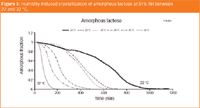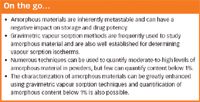Characterizing amorphous materials with gravimetric vapour sorption techniques
Pharmaceutical Technology Europe
Even small amounts of amorphous materials can have a significant effect on the drug product. Are gravimetric vapour sorption techniques an effective solution to characterize amorphous materials?
Amorphous materials in pharmaceutical formulations yield complex and challenging problems concerning the performance, processing and storage of these products.1 The presence of amorphous materials can be wanted or unwanted, depending on the desired or undesired unique properties of the amorphous state. Additionally, during the processing of pharmaceutical solids (e.g., milling, spray drying, tablet compaction, wet granulation and lyophilization), various degrees of disorder in the form of crystal defects and/or amorphous regions may be generated. Even relatively low levels of amorphous material (< 10%) may have a detrimental impact on the stability, manufacturability and dissolution characteristics of the formulated drug product. Amorphous materials are inherently metastable and tend to revert to a more thermodynamically stable, crystalline form. As this instability has a potentially negative impact on storage and drug potency, it is important to quantify and control the amorphous content of pharmaceutically relevant materials. For these reasons, investigating the amount and stability of amorphous material is critical.
Gravimetric vapour sorption methods have been widely used to study amorphous materials; for example, several different gravimetric vapour sorption techniques have been developed to quantify amorphous contents below 1%.2–5 Also, gravimetric vapour sorption has been used to investigate moisture-induced phase changes,6–8 as well as vapour-induced crystallization kinetics.9–13 This paper outlines several recent applications of gravimetric vapour sorption techniques to characterize amorphous materials.

Instrumentation and methods
Gravimetric vapour sorption instruments are well-established methods for determining vapour sorption isotherms. These instruments measure the sample mass change as the vapour environment surrounding the sample is altered. An increase in mass is typically associated with vapour sorption, while a decrease is caused by vapour desorption. The vapour concentration around the sample is controlled by mixing saturated and dry carrier gas streams using electronic mass flow controllers.
In this study, all experiments were performed using a DVS-Advantage (Surface Measurement Systems, UK). The system utilizes an ultramicrobalance with 0.1 μg sensitivity, allowing the measurement of small vapour uptakes. The instrument can actively measure and control the concentration of water and a wide range of organic vapours by using a proprietary optical sensor that is specifically tuned for a range of solvents. This technology allows the instrument to measure and control organic vapour concentrations in real time.
Quantifying amorphous contents below 5%
There are numerous techniques available to quantify moderate-to-high levels of amorphous material in powders. Some of these techniques include differential scanning calorimetry (DSC), density, powder x-ray diffraction, thermal stimulated current spectroscopy, solution calorimetry, FT-Raman, near infrared and modulated DSC. However, there are few techniques that can quantify amorphous contents below 1%. These techniques include solid state nuclear magnetic resonance, microflow calorimetry and parallel beam powder x-ray diffraction. One of the most sensitive techniques is gravimetric vapour sorption.
There are several methods in the literature using gravimetric vapour sorption techniques to quantify amorphous contents.2–5 Most of these methods are based on the amorphous phase sorbing more vapour than the crystalline phase. Amorphous materials typically have a higher surface area and vapour affinity than their crystalline counterparts. For vapour sorption methods, a calibration of known amorphous contents is usually necessary. The equilibrium vapour uptakes at a particular vapour concentration are then plotted against the known amorphous content, and the result is a straight line to which unknown amorphous contents can be compared. Figure 1 shows the octane vapour sorption isotherms (a) and calibration curve (b) for lactose samples with varying amorphous contents. The error margins in Figure 1b were based on the first standard deviation for repeat measurements (n = 3). Amorphous standards were created by making physical mixtures of 100% amorphous and 100% crystalline lactose. The resulting calibration curve and correlation coefficient (R2 = 0.9994) suggests that amorphous contents below 0.5% were achievable with an accuracy of ± 0.3%. Other vapour sorption approaches have also been able to quantify amorphous contents below 1% with similar accuracies.2–5

Figure 1
Vapour-induced phase transitions
As an amorphous material passes through the glass transition, it often transforms from a glassy, hard, brittle material to a less viscous, 'rubber' state.14 Additionally, there is a shift in the molecular mobility of amorphous compounds at the glass transition.15 Above the glass transition, the molecular mobility increases as evidenced by a decrease in viscosity and increasing flow. Temperature often forces the transformation at a characteristic temperature or temperature range (i.e., Tg). Water is a common plasticizer for a range of materials,15 thus the water content in amorphous foods, polymers and pharmaceutical materials can have a significant lowering effect on the glass transition temperature.
If the humidity surrounding an amorphous material is linearly ramped from 0% relative humidity (RH) to a humidity above the water-vapour-induced glass transition, then a shift in vapour sorption characteristics will be evident. Below the glass transition, water sorption will typically be limited to surface adsorption. As the material passes through the glass transition, molecular mobility increases, allowing bulk water absorption. Therefore, the shift in sorption characteristics can be used as a measure of the glass transition.
Above the glass transition, some amorphous materials will relax to their more stable, crystalline state. When the material undergoes an amorphous to crystalline transition, the water sorption capacity decreases drastically, resulting in an overall mass loss as excess water is desorbed during crystallization. This transition mass loss can be used to isolate the particular humidity at which crystallization occurs.

Figure 2
Figure 2 displays a humidity ramping experiment for an amorphous lactose sample. Below the glass transition, water sorption will be dominated by surface adsorption. Above the glass transition, water sorption is dominated by bulk absorption. The transition point between these two regimes is taken as the vapour-induced glass transition. In Figure 2, this occurs at approximately 30% RH. This technique has been used previously on different materials with results similar to those found by DSC.13 As the humidity is increased and water vapour further plasticizes the sample, some low molecular weight materials may relax to the crystalline state. This is observed in Figure 2 by the sharp mass loss at approximately 60% RH. Again, this correlates well to other vapour studies on amorphous lactose.13 The physical changes inferred from the gravimetric data can be further supported by in situ microscopic images collected during the experiment. Figure 3 shows 100x images of amorphous lactose taken at 0% (A), 50% (B), 60% (C) and 90% RH (D). By 50% RH, the sample has changed to the glassy form because the humidity-induced glass transition has been reached. By 60% RH, the sample begins to crystallize and at 90% RH crystallization of amorphous lactose is evident by an increase in the opacity of the image. When combined with the change in mass results in Figure 2, the images shown in Figure 3 identify different humidity-induced phase changes.

Figure 3
Crystallization kinetics
As previously stated, when an amorphous material undergoes a vapour-induced crystallization, there is often a sharp mass loss caused by the lower surface area, surface energy, and/or void spaces in the crystalline phase. This mass loss can be used to monitor the crystallization reaction. Figure 4 shows the moisture-induced crystallization behaviour for amorphous lactose exposed to 55% RH at 25 °C. The distinct mass loss feature observed at approximately 900 min is caused by crystallization of the amorphous lactose. Crystallization is complete by ~ 1200 min in Figure 4.

Figure 4
If experiments similar to that shown in Figure 5 are performed at different temperature or humidity conditions, then the crystallization kinetic mechanism can be elucidated, and crystallization behaviour can be predicted with a wider range of vapour concentration and temperature conditions. Figure 5 shows the crystallization behaviour for an amorphous lactose sample at 51% RH and different temperatures. The scale has been normalized such that time equal to zero is set to the point at which crystallization begins. Moreover, the y-axis is normalized to fraction crystallized (1 = completely amorphous; 0 = completely crystalline). When processed with a mechanistic modelling package, the data in Figure 4 resulted in a mechanism with two competing, two-step reactions. Complete details on the crystallization mechanism can be found in the literature.13 Once the mechanism is determined, it is possible to predict the crystallization behaviour of the amorphous phase with a wide range of storage, processing and packaging conditions. This approach can also be used to study other solid-state transitions, such as dehydration, hydration, or solvation.16–18

Figure 5
Conclusions
Characterization of amorphous materials can be greatly enhanced by using gravimetric vapour sorption techniques. Quantifying amorphous contents below 1% is possible using a range of gravimetric methods and phase change behaviour can also be characterized. This could be in the form of a vapour-induced glass transition or crystallization. Finally, crystallization kinetic modelling can be investigated. Gravimetric vapour sorption techniques can be used for a range of other pharmaceutical applications including: hygroscopicity, hydrate/solvate formation, solid-state transition kinetic modeling, BET surface areas, pore size distribution and diffusion measurements.

On the go...
Daniel Burnett is Head of Application Science for Surface Measurement Systems Ltd (PA, USA).
Nishil Malde is Global Product Manager at Surface Measurement Systems Ltd (UK).
Daryl Williams is Founder and CEO of Surface Measurement Systems Ltd (UK).
References
1. B.C. Hancock and G. Zografi, J. Pharmaceut. Sci., 86(1), 1–12 (1997).
2. A. Saleki-Gerhard, C. Ahlneck and G. Zografi, Int. J. Pharm., 101(3), 237–247 (1994).
3. G. Buckton and P. Darcy, Proc. 1st World Meeting APGI/APV, (Budapest, Hungary, 9–11 May 1995).
4. L. Mackin et al., Int. J. Pharm., 231(2), 227–236 (2002).
5. P.M. Young et al., Drug Dev. Ind. Pharm., 33(1), 91–97 (2007).
6. B.C. Hancock and G. Zografi, Pharmaceut. Res., 11(4), 471–477 (1994).
7. S.M. Lievonen and Y.H. Roos, J. Food Sci., 67(6), 2100–2106 (2002).
8. D.J. Burnett, F. Thielmann and J. Booth, Int. J. Pharm., 287(1–2), 123–133 (2004).
9. R.T. Forbes et al., J. Pharmaceut. Sci., 87(11), 1316–1321 (1998).
10. R. Price and P.M. Young, J. Pharmaceut. Sci., 93(1), 155–164 (2004).
11. D. Lechuga-Ballesteros, A. Bakri and D.P. Miller, Pharmaceut. Res., 20(2), 308–318 (2003).
12. E.A. Schmitt, D. Law and G.G.Z. Zhang, J. Pharmaceut. Sci., 88(3), 291–296 (1999).
13. D.J. Burnett et al., Int. J. Pharm., 313(1–2), 23–28 (2006).
14. L.H. Sperling, Introduction to Physical Polymer Science (Wiley & Sons, New York, NY, USA, 1986).
15. Y.H. Roos, Phase Transitions in Foods (Academic Press, New York, NY, USA, 1995).
16. A. Khawam and D.R. Flanagan, J. Pharmaceut. Sci., 95(3), 472–498 (2006).
17. A.R. Sheth et al., J. Pharmaceut. Sci., 93(12), 3013–3026 (2004).
18. D.J. Burnett, F. Thielmann and T.D. Sokoloski, J. Therm. Anal., 89(3), 693–698 (2007).
Transformations in Drug Development for Cell and Gene Therapies
March 28th 2025As a recognized leader in immunophenotyping for clinical trials, Kevin Lang from PPD discusses how spectral flow cytometry is transforming drug development, particularly in cell and gene therapies like CAR-T. He also dives into his award-winning research, including his 2024 WRIB Poster Award-winning work, and his insights from presenting at AAPS PharmSci360.
Advancing Clinical Trials with Spectral Flow Cytometry: A Conversation with Kevin Lang
March 28th 2025As a recognized leader in immunophenotyping for clinical trials, Kevin Lang from PPD discusses how spectral flow cytometry is transforming drug development, particularly in cell and gene therapies like CAR-T. He also dives into his award-winning research, including his 2024 WRIB Poster Award-winning work, and his insights from presenting at AAPS PharmSci360.
